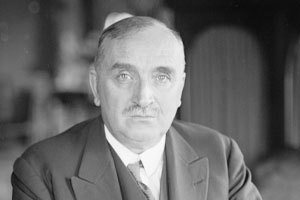
The planned “renovation” of the interior of the medieval Cathedral of Notre Dame in Paris, France, will transform the venerable building into what many call a “woke” modernization. Such a deformation of the sublime shrine to Our Lady must be opposed and protested.
Please Sign Here to Prevent Notre Dame From Being Wreckovated
Reasons for this opposition are best expressed by those who have received signal graces from Our Lady while visiting the Cathedral. Their timeless testimony serves to demonstrate why architecture and design are so important. Those protesting today must unite their voices with those of the past to defend this most sublime work of art.
The Voice of a Poet
Thus, it is opportune to present the words of the illustrious French poet, Paul Claudel (1868-1955), whose life was changed while visiting Notre Dame.
Most Americans are unfamiliar with Paul Claudel. Relatively few of his poems have been translated into English. Britannica provides this brief description, “poet, playwright, essayist, a towering force in French literature of the first half of the twentieth century, whose works derive their lyrical inspiration, their unity and scope, and their prophetic tone from his faith in God.”
In his youth, M. Claudel headed down a path that too many devout Catholic parents have seen their children walk. He discarded the Faith and was well on his way to agnosticism.
December 25, 1886
On the evening of Christmas day, the eighteen-year-old walked into Notre Dame during Vespers—more out of curiosity and boredom than anything else. In his poem December 25, 1886, he describes the overwhelming experience.
Help Remove Jesus Bath Mat on Amazon
After all, you, my Lady, made the first move.
For I was only one of those “standing around” in the sullen inattentive crowd,
One element, “standing around,” lost in the center of the trampling crowded mob.
Then Our Lady worked to save M. Claudel from his indifference, using the ambiance of the Cathedral as her tool.
And the sanctuary in the middle lighted up with gold and linen, and the great carpet with the arrangement of celebrants gold and lace up to the altar.
The roar of Israel toward its God from the beginning of time to the end! in the smoke rising up and spreading,
Our Lady, the Woman-Church, with cries, large with God, erecting her own Magnificat!
And that wretched child I was!—Yes, myself, I repeat!—what did I do to be so carried away?
Satanic Christ Porn-blasphemy at Walmart — Sign Petition
The final verses show the mature—even elderly—man reflecting on the most important day of his youth and the approach of death.
My Lady, that all I have done and all I have written, you might be willing to consider it as nothing at all!
And that I might come before you, blessedly intact and empty,
Basically stripped of all my insipid literature!
Let me pause and collect my thoughts in the expectation of what will not fail to happen in a short time,
Like someone to whom something terrible is going to happen—for example raising his eyes and seeing you! and pretending not to be afraid!
Finding Our Lord and Our Lady in Sacred Spaces
Entering a church is one of M. Claudel’s favorite themes, which he uses in several of his pieces. Consider the beginning of his The Virgin at Noon.
It is noon. The Church is open. I must go in.
Mother of our Lord, I have not come to pray.
I have nothing to give and nothing to ask.
I am here, my Lady, only to look at you.
To look at you, to cry for joy, to know
That I am your son and you are there.
Gothic architecture is all about lifting hearts to God. It forces the person to look toward heaven. With the possible exception of Chartres, the pre-fire Notre Dame is the best example of French Gothic architecture in the world. Many visitors share M. Claudel’s inspiration. Few have used words so beautiful to describe it.
Avoiding Excellence
Such inspirations fell out of favor during the reign of the “Spirit of Vatican II.” The forces of “aggiornamento” eschewed anything that inspired awe. The modernists scrapped the sacrifices of generations by taking figurative (and sometimes literal) sledgehammers to them. The newly-renamed “worship spaces” were redesigned to make people feel comfortable. Everything revolved around the “community” and not the Blessed Mother. High altars were reduced to human proportions. Murals were obliterated with beige paint. Pews were relocated so that the members of the congregation looked at each other instead of turning east toward God.
The beautiful became banal; the awe-inspiring became simply awful.
The modernizers would do well to remember another quotation from M. Claudel.
Please Sign Here to Prevent Notre Dame From Being Wreckovated
“For things and for poems, there is but one way of being new, and that is to be true; there is only one way of being young, and that is to be eternal.”
Notre Dame of Paris does not need to be modernized because the Cathedral embodies the human relationship with the true and the eternal. The entire Church must protest against the restoration and demand that Notre Dame be allowed to retain the beauty that M. Claudel and so many others have found there. The Cathedral is the house of Our Lady and should not be taken from her. It must not be turned into a den of cultural thieves.


